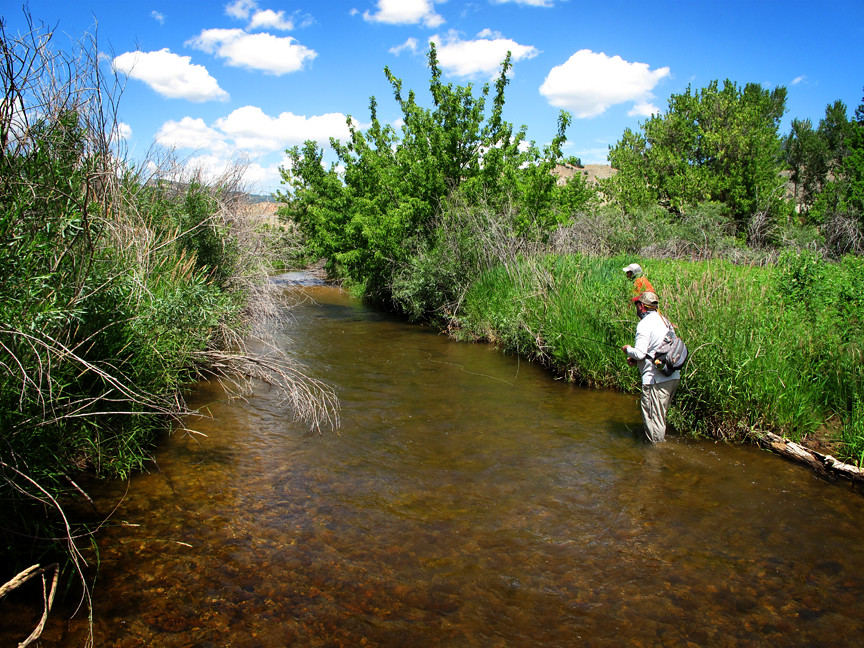
By adjusting your presentation, you can catch good trout on streamers in even small creeks and brooks.
Photo by Phil Monahan
In its most basic form, fishing for trout with streamers is one of the easier ways to catch fish with a fly rod: you simply cast across the river or across-and-downstream and then strip the fly back as it swings through the current below you. Of course, there are ways that you can make this technique more complex and more effective, but the basic cast-and-strip will work a lot of the time. But what if the stream you’re fishing is only a few yards, or even a few feet across? In such cases, there’s really not enough room to cast and swing, but that doesn’t mean you can’t serve up the meat to trout—sometimes big ones—living in these smaller waters. Here’s how.
1. The Downstream Mend
Since you can’t fish across the stream, you’ll have to fish either up- or downstream. A downstream presentation can be extremely effective because it allows you to drop your streamer directly into likely trout lies with great accuracy, and you can impart motion to the fly by either using your rod tip or the power of the current against the fly line.
Start by roll-casting downstream, so that anywhere from 10 to 30 feet of line, plus the leader, are hanging in the current below you. With a short line, you can “swing” the fly from bank to bank by simply pointing your rod in the direction that you want the fly to go. For instance, if the fly is against the right bank, extend your arm and the rod tip to the left, and the fly will follow until it’s downstream of the rod tip.
With a longer line, you can mend the line in the direction you want the fly to move, causing the current to push on the line and drag the fly through the water. The size and power of the mends will give the fly different kinds of action in the water: a bunch of short, sharp mends will cause the fly to dart in short spurts, whereas one large mend will cause a smooth swing. You can also shake the rod tip, raise or lower it, or make sharp spirals to impart an erratic, lifelike action to the streamer.

To fish downstream, use your rod trip to mend or control the fly.
Photo courtesy Mike Schmidt, Angler’s Choice Flies
2. The High-Stick Dead Drift
To work upstream, try dead-drifting your streamer as if it were a nymph, but in this case you are trying to imitate a stunned or injured baitfish. Patterns tied with marabou or outfitted with rubber legs work well with this technique, because the materials undulate and wave even when you’re not stripping the fly.
When you are dead-drifting a streamer, use your line to control the fly, as you would when fishing a nymph. A high-sticking technique works great when you want to float the streamer along a cut bank or through a deep slot between two boulders. Start by casting upstream, and then raise your rod tip to pick up slack as the fly approaches. Once the fly goes past you, lower the rod tip to feed slack into the drift. The advantage of a streamer in these situations is that the take is rarely subtle. When a trout attacks a baitfish, it almost always does so aggressively—no strike indicator necessary.
3. The Downstream Strip
When you’re fishing a stream that has cutbanks or deep pools, you can trigger strikes from lurking trout by stripping your streamer downstream. Of course, you have to strip quickly—because the current is already bringing the fly toward you—but try mixing things up with erratic retrieves that suggest an injured or panicked baitfish.
Cast upstream right along the bank or along any woody structure, such as a fallen tree. Give the fly a second to sink, and then strip like mad to pick up the slack and make contact with the fly. Then alternate stripping and stopping to make the fly dart and stop, rise and sink. Expect the strike on the first strip after a pause.
Fishing streamers in small waters requires you to think a little more about your presentation, but the rewards can be outstanding. Big fish that never ate your dry flies or nymphs in the past will smack a meaty streamer. You may be surprised by the size of the fish you’ll find.
No comments:
Post a Comment